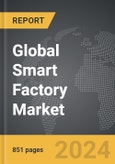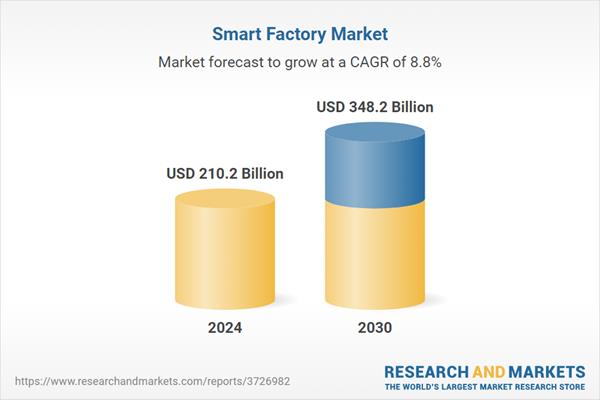The global market for Smart Factory was valued at US$210.2 Billion in 2024 and is projected to reach US$348.2 Billion by 2030, growing at a CAGR of 8.8% from 2024 to 2030. This comprehensive report provides an in-depth analysis of market trends, drivers, and forecasts, helping you make informed business decisions. The report includes the most recent global tariff developments and how they impact the Smart Factory market.
Technological advancements are the backbone of smart factories, driving innovation and efficiency to unprecedented levels. IoT sensors and devices collect vast amounts of data from every aspect of the production line, from machine performance to environmental conditions. This data is then analyzed using AI and machine learning algorithms to identify patterns and insights that can improve operational efficiency. For instance, AI can optimize production schedules, predict maintenance needs, and adjust processes in real-time to enhance productivity and reduce costs. Robotics and automation play a crucial role, handling repetitive and hazardous tasks with precision and consistency, freeing human workers to focus on more complex and creative functions. Furthermore, the integration of augmented reality (AR) and virtual reality (VR) technologies enhances training, maintenance, and design processes. AR can provide technicians with real-time information and visual guidance during maintenance tasks, while VR can simulate complex production environments for training purposes, improving accuracy and reducing errors.
The growth in the smart factory market is driven by several factors. The increasing demand for operational efficiency and productivity is a significant driver, as manufacturers seek to remain competitive in a rapidly evolving market. Technological advancements in IoT, AI, and robotics are making smart factory solutions more accessible and effective, encouraging their adoption across various industries. The rising need for flexibility and agility in manufacturing, particularly in response to fluctuating market demands and supply chain disruptions, is also propelling the market forward. For example, smart factories can quickly adapt to changes in product design or production volume without extensive reconfiguration. Additionally, the emphasis on sustainability and energy efficiency is pushing manufacturers to adopt smart technologies that can optimize resource usage and reduce waste. Government initiatives and investments in smart manufacturing technologies are further supporting market growth, as countries aim to bolster their manufacturing sectors and enhance economic resilience. These initiatives often include funding for research and development, tax incentives for technology adoption, and the creation of industry standards for smart manufacturing. Together, these factors are fostering a dynamic and expanding market for smart factories, presenting significant opportunities for innovation and development in the manufacturing industry.
Segments: Type (Control Equipment & Software, Reporting & Analysis Software, Measurement Devices, Connectivity Solutions); End-Use (Automotive, Oil & Gas, Aerospace & Defense, Electronics, Industrial Equipment, Other End-Uses).
Geographic Regions/Countries: World; USA; Canada; Japan; China; Europe; France; Germany; Italy; UK; Rest of Europe; Asia-Pacific; Latin America; Rest of World.
The analysts continuously track trade developments worldwide, drawing insights from leading global economists and over 200 industry and policy institutions, including think tanks, trade organizations, and national economic advisory bodies. This intelligence is integrated into forecasting models to provide timely, data-driven analysis of emerging risks and opportunities.
Global Smart Factory Market - Key Trends & Drivers Summarized
A smart factory represents the pinnacle of modern manufacturing, where advanced technologies like the Internet of Things (IoT), artificial intelligence (AI), and robotics converge to create highly automated and self-optimizing production environments. In a smart factory, machines and systems are interconnected, enabling real-time data exchange and decision-making processes that enhance efficiency, reduce downtime, and improve product quality. This interconnectedness allows for predictive maintenance, where potential equipment failures are anticipated and addressed before they occur, minimizing disruptions. Smart factories also use digital twins, which are virtual replicas of physical assets, to simulate and optimize production processes. This technology allows manufacturers to experiment with different scenarios and make adjustments in a virtual environment before implementing changes in the physical factory, resulting in more agile and responsive manufacturing capabilities.Technological advancements are the backbone of smart factories, driving innovation and efficiency to unprecedented levels. IoT sensors and devices collect vast amounts of data from every aspect of the production line, from machine performance to environmental conditions. This data is then analyzed using AI and machine learning algorithms to identify patterns and insights that can improve operational efficiency. For instance, AI can optimize production schedules, predict maintenance needs, and adjust processes in real-time to enhance productivity and reduce costs. Robotics and automation play a crucial role, handling repetitive and hazardous tasks with precision and consistency, freeing human workers to focus on more complex and creative functions. Furthermore, the integration of augmented reality (AR) and virtual reality (VR) technologies enhances training, maintenance, and design processes. AR can provide technicians with real-time information and visual guidance during maintenance tasks, while VR can simulate complex production environments for training purposes, improving accuracy and reducing errors.
The growth in the smart factory market is driven by several factors. The increasing demand for operational efficiency and productivity is a significant driver, as manufacturers seek to remain competitive in a rapidly evolving market. Technological advancements in IoT, AI, and robotics are making smart factory solutions more accessible and effective, encouraging their adoption across various industries. The rising need for flexibility and agility in manufacturing, particularly in response to fluctuating market demands and supply chain disruptions, is also propelling the market forward. For example, smart factories can quickly adapt to changes in product design or production volume without extensive reconfiguration. Additionally, the emphasis on sustainability and energy efficiency is pushing manufacturers to adopt smart technologies that can optimize resource usage and reduce waste. Government initiatives and investments in smart manufacturing technologies are further supporting market growth, as countries aim to bolster their manufacturing sectors and enhance economic resilience. These initiatives often include funding for research and development, tax incentives for technology adoption, and the creation of industry standards for smart manufacturing. Together, these factors are fostering a dynamic and expanding market for smart factories, presenting significant opportunities for innovation and development in the manufacturing industry.
Report Scope
The report analyzes the Smart Factory market, presented in terms of units. The analysis covers the key segments and geographic regions outlined below.Segments: Type (Control Equipment & Software, Reporting & Analysis Software, Measurement Devices, Connectivity Solutions); End-Use (Automotive, Oil & Gas, Aerospace & Defense, Electronics, Industrial Equipment, Other End-Uses).
Geographic Regions/Countries: World; USA; Canada; Japan; China; Europe; France; Germany; Italy; UK; Rest of Europe; Asia-Pacific; Latin America; Rest of World.
Key Insights:
- Market Growth: Understand the significant growth trajectory of the Control Equipment & Software segment, which is expected to reach US$149.0 Billion by 2030 with a CAGR of a 9.0%. The Reporting & Analysis Software segment is also set to grow at 10.1% CAGR over the analysis period.
- Regional Analysis: Gain insights into the U.S. market, valued at $35.7 Billion in 2024, and China, forecasted to grow at an impressive 9.9% CAGR to reach $62.1 Billion by 2030. Discover growth trends in other key regions, including Japan, Canada, Germany, and the Asia-Pacific.
Why You Should Buy This Report:
- Detailed Market Analysis: Access a thorough analysis of the Global Smart Factory Market, covering all major geographic regions and market segments.
- Competitive Insights: Get an overview of the competitive landscape, including the market presence of major players across different geographies.
- Future Trends and Drivers: Understand the key trends and drivers shaping the future of the Global Smart Factory Market.
- Actionable Insights: Benefit from actionable insights that can help you identify new revenue opportunities and make strategic business decisions.
Key Questions Answered:
- How is the Global Smart Factory Market expected to evolve by 2030?
- What are the main drivers and restraints affecting the market?
- Which market segments will grow the most over the forecast period?
- How will market shares for different regions and segments change by 2030?
- Who are the leading players in the market, and what are their prospects?
Report Features:
- Comprehensive Market Data: Independent analysis of annual sales and market forecasts in US$ Million from 2024 to 2030.
- In-Depth Regional Analysis: Detailed insights into key markets, including the U.S., China, Japan, Canada, Europe, Asia-Pacific, Latin America, Middle East, and Africa.
- Company Profiles: Coverage of players such as Daimler AG, Fortinet, Inc., Advantech Co., Ltd., Festo Belgium NV, AT&T Enterprise Business and more.
- Complimentary Updates: Receive free report updates for one year to keep you informed of the latest market developments.
Some of the 209 companies featured in this Smart Factory market report include:
- Daimler AG
- Fortinet, Inc.
- Advantech Co., Ltd.
- Festo Belgium NV
- AT&T Enterprise Business
- Arburg GmbH + Co. KG
- Critical Manufacturing S.A.
- ebm-papst Mulfingen GmbH & Co. KG
- Exor International SpA
- Flocktons TVP
- Comau SpA
- EOS GmbH
- CyberX
- Altizon Systems Pvt., Ltd.
- BinMaster
Tariff Impact Analysis: Key Insights for 2025
Global tariff negotiations across 180+ countries are reshaping supply chains, costs, and competitiveness. This report reflects the latest developments as of April 2025 and incorporates forward-looking insights into the market outlook.The analysts continuously track trade developments worldwide, drawing insights from leading global economists and over 200 industry and policy institutions, including think tanks, trade organizations, and national economic advisory bodies. This intelligence is integrated into forecasting models to provide timely, data-driven analysis of emerging risks and opportunities.
What’s Included in This Edition:
- Tariff-adjusted market forecasts by region and segment
- Analysis of cost and supply chain implications by sourcing and trade exposure
- Strategic insights into geographic shifts
Buyers receive a free July 2025 update with:
- Finalized tariff impacts and new trade agreement effects
- Updated projections reflecting global sourcing and cost shifts
- Expanded country-specific coverage across the industry
Table of Contents
I. METHODOLOGYMII. EXECUTIVE SUMMARY2. FOCUS ON SELECT PLAYERSIII. MARKET ANALYSISCANADAITALYREST OF EUROPEREST OF WORLDIV. COMPETITION
1. MARKET OVERVIEW
3. MARKET TRENDS & DRIVERS
4. GLOBAL MARKET PERSPECTIVE
UNITED STATES
JAPAN
CHINA
EUROPE
FRANCE
GERMANY
UNITED KINGDOM
ASIA-PACIFIC
LATIN AMERICA
Companies Mentioned (Partial List)
A selection of companies mentioned in this report includes, but is not limited to:
- Daimler AG
- Fortinet, Inc.
- Advantech Co., Ltd.
- Festo Belgium NV
- AT&T Enterprise Business
- Arburg GmbH + Co. KG
- Critical Manufacturing S.A.
- ebm-papst Mulfingen GmbH & Co. KG
- Exor International SpA
- Flocktons TVP
- Comau SpA
- EOS GmbH
- CyberX
- Altizon Systems Pvt., Ltd.
- BinMaster
Table Information
| Report Attribute | Details |
|---|---|
| No. of Pages | 851 |
| Published | April 2025 |
| Forecast Period | 2024 - 2030 |
| Estimated Market Value ( USD | $ 210.2 Billion |
| Forecasted Market Value ( USD | $ 348.2 Billion |
| Compound Annual Growth Rate | 8.8% |
| Regions Covered | Global |









